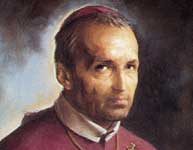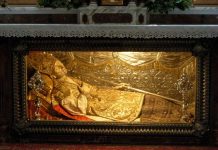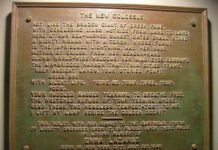The Book of Revelation, also known as the Apocalypse, stands as one of the most image-laden parts of Scripture, and as such, there is much for composers to conjure up in the listener’s mind through word painting. St. John paints vivid pictures with his depictions of harps, the seven trumpets, but also with the seven hymns that appear within the text. Even without explicit reference to music and musical instruments, there are numerous events within the Apocalypse that lend themselves musically, such as the voice like thunder, which could be orchestrated in many creative ways. Franz Schmidt, a composer of the late-Romantic period, wrote what is perhaps the first classical work to set the entirety of the Book of Revelation, in his masterful oratorio, “the Book with Seven Seals.”
Franz Schmidt (1874–1939) was born in Pressburg, now called Bratislava, in what was then the Austro-Hungarian Empire. His was a musical household, and his mother gave him his first piano lessons. He later studied the organ and composition, as well as the cello, soon unofficially becoming principle cellist in the Vienna Court Opera and therefore also the Vienna Philharmonic, where he worked under the famous conductor Gustav Mahler (1860–1911). Mahler himself was one of the most important composers of his time, as well as being a bridge figure between the 19th-century Romanticism and 20th-century Modernism in music. As Schmidt worked his way up the ranks of the Viennese musical establishment, he came to teach first at the Conservatory of the Gesellschaft der Musikfreunde and later at the Vienna Hochschule für Musik, and was granted an honorary doctorate from the University of Vienna in 1934. He was certainly a prominent figure in Austro-German music, being an acquaintance of none other than Arnold Schoenberg (1874–1956), and Dohnányi Ernő (1877-1960), as well as the aforementioned Mahler, who said that Schmidt was, “the most musical man in Vienna.”[i]
While less is known of Schmidt’s faith than other composers, such as Bach or Bruckner, he was nonetheless a Roman Catholic and remained so for his entire life. According to Schmidt’s autobiography, “music had ‘first entered [his] soul through the church.’ There he heard the great organ (‘the grandest and most perfect revelation of music’), which he found so much better than the amateur orchestra used for High Mass.”[ii] He also took some of his first organ and composition lessons with a Franciscan brother, Felicien Josef Moczik (1861–1917), an amateur organist and musician but a trained painter, who greatly influenced the young Schmidt.
His last completed work, often described as his masterpiece, is Schmidt’s oratorio, “The Book with Seven Seals,” (Das Buch mit sieben Siegeln in German). Before studying Schmidt’s piece, one should note that the oratorio genre originates from unstaged, quasi-operatic works, which were first composed in Rome during the early 17th century, when it was forbidden to perform operas during Lent. Therefore, a work, with a sacred text or story, could be presented inside of an oratory, essentially a small chapel, without breaking the ban. The oratory, from the Latin for prayer, is where we get the word oratorio. Schmidt’s towering piece of music, approximately 110 minutes long, traces the story of the Book of Revelation. St. John is portrayed by a heldentenor, or a heroic tenor, which was a favourite voice type of Richard Wagner (1813–1883), who used it in no less than eight of his operas. A quartet of soprano, alto, tenor and bass voices make up the remainder of the soloists in Schmidt’s oratorio. A mixed choir is also included, indicated as requiring “as many voices as possible.”[iii] A large orchestra and a pipe organ accompany the singing. While it is impossible to give any justice to this monumental work in a short analysis such as this one, I will select a few prominent passages of interest.
The work opens with the heldentenor singing a somewhat truncated form of St. John’s opening address from the Apocalypse. A punchy pattern of quarter notes from the orchestra accompanies the Evangelist, giving the beginning a joyous atmosphere. After the heldentenor sings, “Amen,” the air soon seems to shift, moving toward a darker, more somber section featuring the bass soloist. This is the voice of God, who sings, “I am Alpha and Omega, the beginning and the ending, the first and the last. Come hither, come up hither and I will show thee what hereafter must come to pass.”[iv]
The atmosphere varies greatly over the course of the work, at times it is jubilant, and others, it is almost penitential in nature. Outbursts of bombastic praise give way to anguished pleading, as seen in the fugal section for choir and organ during the opening of the fifth seal. St. John sings, “And I beheld, the Lamb undid the fifth seal, there saw I under the altar the souls of the martyrs, souls of them that were slain for the word of God Almighty, and for the testimony whereto they held faithful, and they spoke…” The full chorus then enters loudly, singing as the collective martyrs, “Lord, our holy and our righteous God, how long wilt Thou not judge, wilt not avenge our blood on those men that dwell on earth below?” A choral fugue ensues, repeating this text, with the organ playing a running figure of quick sixteenth notes, giving a frenetic sense of urgency to this section. It is extremely contrapuntal, but also very chromatic, making it feel both unstable and mysterious.
Another section to consider is that which begins, “A woman clothed with the sun, the moon under her feet, and upon her head a crown of twelve stars…”[v] The woman brings forth a Child, and a war begins in Heaven. The music becomes increasingly jagged, jarring, and dissonant, with the full orchestra seeming to struggle internally against itself, mirroring the heavenly war depicted in the Apocalypse.
The fourth and last section, before St. John’s closing address, and before the final Amen, is an exultant “Hallelujah Chorus.” Schmidt was undoubtedly familiar with Handel’s Messiah (1751) and its own famous “Hallelujah Chorus.” This is perhaps the most familiar piece of Western classical music today for the average listener. It is unlikely that Schmidt would have been unacquainted with it, especially for a man described as “having the entire musical literature at [his] fingertips,” and able to play almost any piece at the piano from memory.[vi] Messiah is one of the few works in Western music history to remain performed long after a given composer’s death, especially from the Baroque period, and indeed, it is still performed hundreds of times every year. Schmidt’s own “Hallelujah Chorus” is largely an adaptation of an organ prelude that Schmidt composed in 1928, but with the addition of the orchestra and chorus, it becomes an entirely new work. It repeats the word, “hallelujah,” again and again, but alternates it with textual bits of praise, such as, “Praise ye the Lord! Worship Him and thank Him for His Mercy!”[vii]
The Evangelist soon gives his closing address, as the piece comes to an end, with the opening orchestral accompaniment returning, and the heldentenor singing of all that which was revealed to him. St. John concludes his final address, with the full chorus, organ and orchestra returning in an ecstatic plagal cadence on this, the last “amen.”
Schmidt’s last major composition, “The Book with Seven Seals” stands also as his most religious piece. While little is known about his personal devotion, he brought forth a glorious oratorio on an apocalyptic text. The interspersion of the biblical narrative, as well as the use of hymn-like outbursts of praise, mark this as a deeply profound work of faith.
For a complete performance, please see this link: https://www.youtube.com/watch?v=gQfMFH7UU7s
I also highly recommend listening to his Third Symphony, as well as the Chaconne (either in the version for organ or orchestra).
[i] Corfield, Thomas B. Franz Schmidt: 1874-1939: A Discussion of His Style and Special Reference to the Four Symphonies and “Das Bush mit sieben Siegeln.” New York: Garland, 1989. 3.
[ii] Franklin, Peter. “The Case of Franz Schmidt.” The Musical Times 130, no. 1752 (1989): 64. doi:10.2307/966348.
[iii] Schmidt, Franz. “Das Buch mit Sieben Siegeln.” London, UK: Universal Edition Ltd., 1954. X.
[iv] Schmidt, “Das Buch mit Sieben Siegeln.” 11-14.
[v] Ibid. 216-217.
[vi] Laki, Peter. “Franz Schmidt (1874-1939) and Dohnányi Ernő (1877-1960): A Study in Austro-Hungarian Alternatives.” The Musical Quarterly 80, no. 2 (1996): 363. www.jstor.org/stable/742372.
[vii] Schmidt, Franz. “Das Buch mit Sieben Siegeln.” London, UK: Universal Edition Ltd., 1954. 366-367.











